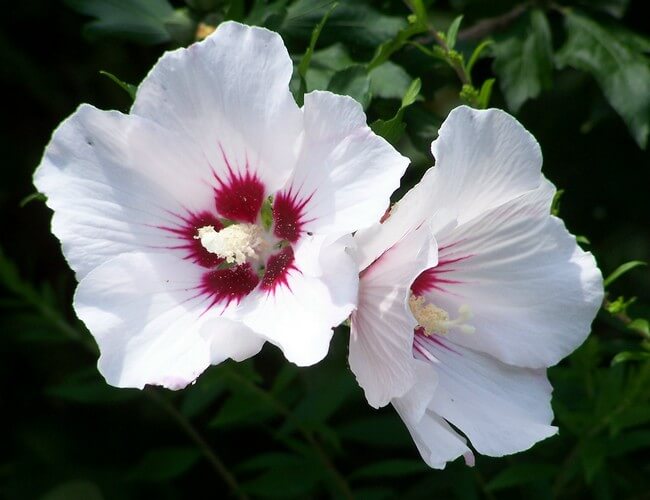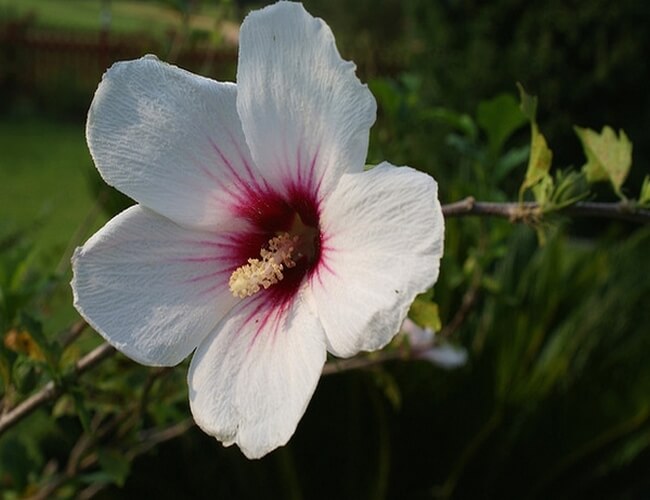The National Flower of South Korea is Hibiscus Syriacus or Rose Sharon. It belongs to Malvaceae family and order of Malvales. Its scientific name is hibiscus. It is also known as Korean rose or rose of Sharon.
It is commonly known by several names rose of Sharon (especially in North America), Syrian ketmia or rose mallow (United Kingdom) and St Joseph’s rod (Italy). South Korean national flower is a hardy, hairy, thick and evergreen plant.
Its top upside shape is vase type and small tree growing 2.4–5 m (7–14 ft.) tall and 1.5–3 m (5–10 ft.) wide. It has silky leaves and independent, brilliant red flowers in summer and autumn.
The 5-petaled flowers are 10 cm (4 in) in diameter, with prominent orange-tipped red contains pollen usually borne on a stalk. The flowers have both male and female organs and pollinated by insects.
- Read also: Lotus Flower
Hibiscus trees grow good shape and could be widely used to uniform gardens. This plant absorbs unwanted gasses and keeps the air clean.
The scientific name of the flower Hibiscus syriacus in Korea is mugunghwa. The word mugunghwa has actual roots from the Korean word mugung which means “eternity” or “endless abundance “.That’s why it’s symbolic meaning signify different national symbol of South Korea which contain hibiscus syriacus.
10 Facts about Hibiscus Syriacus Flower
- Hibiscus syriacus is the native, famous and popular flower of South Korea.
- Hibiscus Syriacus flower color looks pink and white.
- It is the country garden flower since immemorial time.
- Its leaves use in herbal tea and flowers can be eaten.
- It appears on various official document of the country.
- In 18th century it becomes most popular in English gardens and American colonies by the name of Althea “frutex “and “Syrian ketmia”
- Several countries like Egypt, Sudan, Mexico, Jamaica, Cuba, Filipina, and Europe have their own proportion of tea made with the hibiscus flower or its leaf.
- The above countries treat different medical problems with the help of leaf extraction or tea.Which includes difficulties with the genital problems, nerves system, cardiac diseases, colds, upper respiratory illness such as cough, and sore throat.
- The flower used to make tea with a unique, delicious taste. The tea is caffeine free, also it is distinctive, vibrant, with a natural color, and is rich in Vitamin C.
- Hibiscus tea has a pleasant fragrance and is known to be a natural body refrigerant in North Africa.
- It has great importance in the country because it is gracefully and poetically compare with Korean national anthem in south Korea.
- The flowers are also used as food either raw or cooked. The flowers will not lose strength until evening, so they can also be used as a long-lasting food sauce or side dish.
- The people of Egypt believed that tea made with red hibiscus flowers and sepals could induce sexually unlimited intense desire in women. It was observed that for many centuries Egyptian women were forbidden to drink Hibiscus tea.
- The same species of the hibiscus that is Hibiscus Rosa Sinensis flower helps in inducing abortion, provide treatment for a headache.
Fresh leaves are sometimes used as a spinach alternate. - The process of decoction (the extraction of water-soluble drug substances by boiling) prepare a lotion which uses in the treatment of fevers.
- The type of Malaysian flower (hibiscus tiliaceous) used in ear infection and inflammations and as laxative and lubricant in child birth.
- south Korean (Hibiscus syriacus) flower meaning Hibiscus syriacus was named 1400years ago . The word mugunghwa has actual roots from the Korean word mugung which means “eternity” or “endless abundance “ it is not originally related to the true roses comes in our common experience.
- The flower locally known as bunga raya. The word bunga in Malaysian language (Malay) means “flower“, while raya in Malay means “celebratory” or “splendid, impressive “. That’s why The Hibiscus rosa-sinensis is literally known as the “celebratory flower” in Malay.
- The red of the petals symbolizes the courage, life, and rapid growth of the Malaysian, and the five petals represent the five Rukun Negara(Malaysian declaration of national philosophy instituted by royal proclamation on Merdeka Day) of Malaysia. The flower can be found imprinted on the notes and coins of the Malaysian ringgit.
- It performs good role in herbal treatment hair. The leaves and flowers are mix and beaten into a paste and poultice( Plaster) (a medical dressing consisting of a soft heated mass of meal or clay that is spread on a cloth and applied to the skin to treat inflamed areas or improve circulation etc.) onto cancerous swellings and mumps (an acute contagious viral disease characterized by fever and by swelling of the parotid glands).
Hibiscus Syriacus Flower meaning
The scientific name of the flower Hibiscus syriacus in Korea is mugunghwa. The word mugunghwa has actual roots from the Korean word mugung which means “eternity” or “endless abundance “.That’s why it’s symbolic meaning signify different national symbol of South Korea which contain hibiscus syriacus.
Why is Hibiscus Syriacus the national flower of South Korea ?
Every country has unique emblems which range from anthem, uniform, tree, bird, animal and a flag alongside this country also have a national flower to represent its gardens, trade and forest habitation. All the national flowers signify certain principles that a nation stands for. Let’s know the South Korea national flower.
Rose of Sharon is five petal attractive flower available in several colors. The flower blooming season starts from July to October every year and it can be seen everywhere.it is the beauty of houses ,gardens and street etc.
It was referenced in text for the first time fourteen hundred years ago (1400 years). Somewhere it is known as immemorial .
It has great importance both among the people and officially because of this it is written as reference in the national anthem of the country. That is gracefully and poetically compare with Korean national anthem in south Korea.
The Hibiscus Syriacus flower has various medical uses and also it is use for beauty of offices, schools and colleges, street, gardens and houses. Due to all these reason and especially its reference in national anthem it become the national flower of South Korea country.
Some other Similar flowers are: Cattleya Orchid flower & Edelweiss Flower


